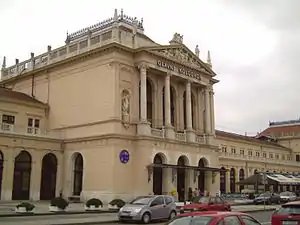M101 railway (Croatia)
The state border–Savski Marof–Zagreb Glavni kolodvor railway (Croatian: Pruga državna granica–Savski Marof-Zagreb Glavni kolodvor), officially designated as the M101 railway, is a 26.709-kilometre (16.596 mi) railway line in Croatia, connecting the nation's capital Zagreb and its main railway station to the Slovene railway network west of Savski Marof and further on with Ljubljana.[1][maps 1] Its route follows the Sava Valley.[2] It is an integral part of the Pan-European Corridor X running from Salzburg and Ljubljana towards Skopje and Thessaloniki.
| Savski Marof–Zagreb railway | ||||||||||||||||||||||||||||||||||||||||||||||||||||||||||||||||||||||||||||||||||||||||||||||||||||||||||||||||||||||||||||||||||||||||||||||||||||||||
|---|---|---|---|---|---|---|---|---|---|---|---|---|---|---|---|---|---|---|---|---|---|---|---|---|---|---|---|---|---|---|---|---|---|---|---|---|---|---|---|---|---|---|---|---|---|---|---|---|---|---|---|---|---|---|---|---|---|---|---|---|---|---|---|---|---|---|---|---|---|---|---|---|---|---|---|---|---|---|---|---|---|---|---|---|---|---|---|---|---|---|---|---|---|---|---|---|---|---|---|---|---|---|---|---|---|---|---|---|---|---|---|---|---|---|---|---|---|---|---|---|---|---|---|---|---|---|---|---|---|---|---|---|---|---|---|---|---|---|---|---|---|---|---|---|---|---|---|---|---|---|---|---|
 | ||||||||||||||||||||||||||||||||||||||||||||||||||||||||||||||||||||||||||||||||||||||||||||||||||||||||||||||||||||||||||||||||||||||||||||||||||||||||
| Technical | ||||||||||||||||||||||||||||||||||||||||||||||||||||||||||||||||||||||||||||||||||||||||||||||||||||||||||||||||||||||||||||||||||||||||||||||||||||||||
| Line length | 26.709 km (16.6 mi) | |||||||||||||||||||||||||||||||||||||||||||||||||||||||||||||||||||||||||||||||||||||||||||||||||||||||||||||||||||||||||||||||||||||||||||||||||||||||
| Track gauge | 1435 mm | |||||||||||||||||||||||||||||||||||||||||||||||||||||||||||||||||||||||||||||||||||||||||||||||||||||||||||||||||||||||||||||||||||||||||||||||||||||||
| Electrification | 25 kV 50 Hz AC | |||||||||||||||||||||||||||||||||||||||||||||||||||||||||||||||||||||||||||||||||||||||||||||||||||||||||||||||||||||||||||||||||||||||||||||||||||||||
| Operating speed | 120 km/h (74.6 mph) max. | |||||||||||||||||||||||||||||||||||||||||||||||||||||||||||||||||||||||||||||||||||||||||||||||||||||||||||||||||||||||||||||||||||||||||||||||||||||||
| ||||||||||||||||||||||||||||||||||||||||||||||||||||||||||||||||||||||||||||||||||||||||||||||||||||||||||||||||||||||||||||||||||||||||||||||||||||||||
The railway connects to the M102 railway at its eastern terminus in Zagreb, linking Zagreb with railways extending north to Budapest and east to Belgrade. Furthermore, the railway connects to the M202 linking Rijeka, the R201 to Čakovec via Zabok and the L102 railway to Kumrovec. The L102 is largely unused, and only a short section extending to the village of Harmica is in use.[3] The M405 railway, a short line branching off to the south between the Zagreb Zapadni railway station and Zagreb Glavni kolodvor. The M405 terminates at the Trešnjevka wye, where it connects to the M104 and M202 railways.[4]
History
The Savski Marof–Zagreb railway was opened in 1862 as part of a railway line from Zidani Most to Sisak, which was not only the first railway line to Zagreb but the first on the territory of Croatia at all. The second track was commissioned in 1944.[5]
It was the route of the Orient Express service from 1919 to 1977.[6] It is electrified and double-tracked.[2]
See also
Maps
- Overview map of the state border–Savski Marof–Zagreb Glavni kolodvor railway (Map). OpenStreetMap. Retrieved December 11, 2013.
References
- "Odluka o razvrstavanju željezničkih pruga" [Decision on Classification of Railways]. Narodne novine (in Croatian). Government of Croatia. 2006.
- 2014 HŽ network statement Archived 2013-10-04 at the Wayback Machine
- "Karta pruga" [Railway map] (in Croatian). Croatian Railways. Archived from the original on 2013-10-17.
- "Annex 3.1. Line classification". Network Statement 2014. HŽ Infrastruktura. p. 2. Archived from the original (PDF) on 2013-05-03.
- Žuljić, Stanko (1978). "Razvoj sistema magistralnih željeznićkih pruga na području SR Hrvatske [Development of the railway network on the territory of the SR Croatia]". Geografski Glasnik (in Croatian) (40).
- Smith, Mark. "A history of the Orient Express". Seat Sixty One. Retrieved 2013-03-13.
External links
 Media related to M101 railway (Croatia) at Wikimedia Commons
Media related to M101 railway (Croatia) at Wikimedia Commons